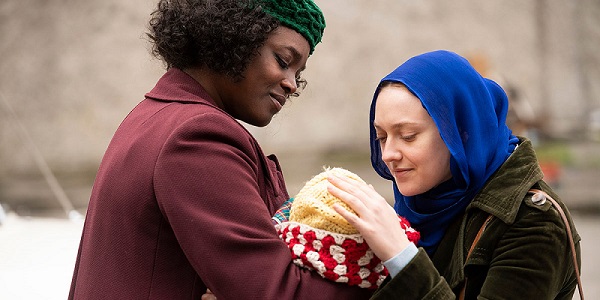
Do you know that Dakota Fanning is now twenty-six years of age? Almost two decades ago she was the youngest nominee in SAG history for the prestige picture I Am Sam, which kickstarted a prolific child actor career that included massive roles in films such as The Cat in the Hat (featuring the cinematographic talents of Emmanuel Lubezki), War of the Worlds, and Charlotte’s Web, all before teenagedom. Said teenagedom has been less kind to Elle’s older sister, as the actress has moved into a more independent realm with turns in films such as Very Good Girls and the worst Kelly Reichardt film. Recently, even that has begun to trail off. I remember feeling a jolt of remember in the form of, “hey, that’s Dakota Fanning,” for her brief, but excellent, cameo in Once Upon a Time in Hollywood as a notorious Manson Family member.
Fanning is the lead of Sweetness in the Belly, the adaptation of the novel of the same name by celebrated author Camilla Gibb. Fanning’s mere presence constitutes a fascinating conundrum surrounding the film. For the unaware, Sweetness in the Belly details the life of a white, Muslim, Ethiopian, orphan refugee named Lily, who makes a living in England as a nurse while attempting to find a lost love who she was separated from amidst the chaos of the Derg coup. Did you see all of those qualifiers used to describe the circumstances that make up Lily? They exist in both novel and cinematic form. Fanning’s presence is merely a form of textual adherence.
But her presence also raises the question of why this story in the first place. Regretfully, a copy of Gibb’s novel sits unopened on my shelf, and thus, I cannot provide an answer regarding the purpose as explained by the novel. For the film, however, I can offer that there seems to be little point to Lily Randolph Abdal’s thematic existence, precisely because of how the film feels. There’s a difference between novelistic and novel-like. The former is about details, lattices and connections. The latter is about happenstance and needlessly propulsive narrative progression, and usually leads to madcap disasters like John Crowley’s The Goldfinch. The chief difference is in feel. Novelistic entails a feeling of reading a novel, novel-like induces the feeling of watching a novel.
Novel-like is the approach favoured by director Zeresenay Mehari here. Again, I haven’t read Gibb’s original. A cursory glance suggests the back and forth temporal structure is present in both versions. There are two timelines Sweetness in the Belly is moving between. A past in Ethiopia as it transitions from Selassie’s rule to a military one, and a present in a Thatcher’s England pointedly disdainful towards foreigners. I am uncertain if a structural change would offer a greater truth, but I can confidentially say that adhering this stringently to such a structure offers little favours. In doing so, it feels like a form of deflection, communicating to the audience that what matters here is fidelity, and any problematic issues you’d like to raise need to be taken up with the novel.
Quite frankly, it doesn’t work. There’s a delicate balance that must be struck to make this text work. Lily needs to be believable, the romance needs to feel felt, and the acknowledgement of her privilege needs to be more than cursory. The middle of the three is the one the film succeeds best at, but in regards to the bookending two, the film whiffs. In general I believe Fanning is great, but here she is not particularly convincing as Lily. The script has her constantly reference the Great Abdul who she studied under as a orphaned child (a touch that screams “THIS IS THE NOVEL TALKING”), but it feels false under any sort of scrutiny.
The romance kind of works, and for two notable reasons. The first is the screen presence of Yahya Abdul-Mateen II who plays the love interest Aziz. The camera is drawn to him, and he elevates each scene that he is in. The other is the setting. Mehari gets the most out of the Ethiopian location shooting. In particular, the color design and palettes visually pop.
But the film really struggles to provide a meaningful response to the fact that Lily is white. Most of this is located in the film’s initial stages, where she allowed into Europe precisely because she is white, and her paperwork has the name Randolph on it (the reasoning behind this is a spoiler I feel is impolite to provide). But it’s mostly relegated to the film’s actual focus, playing with its dual story lines. Originally, Saoirse Ronan was in contention to play Lily before dropping out. When you see Sweetness in the Belly this choice makes sense. All moments are funneled towards the progression of the story, with little time to really getting into the implications of what the story suggests about life as a broad concept. It is the quintessential novel adaptation, playing out full steam ahead in front of your eyes.
- Release Date: 5/8/2020



